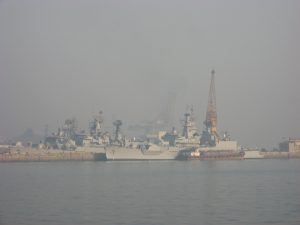By Shishir Upadhyaya

The latest announcement about the creation of India’s first Maritime Theater Command by 2021 is a seminal development and part of the long overdue transformation of India’s armed forces. Reportedly, the commander-in-chief of the new maritime theater command, who will be based at Karwar on the west coast of India, will exercise full operational control over extant western and eastern naval fleets, maritime strike fighter jets and transport aircraft from both the air force and the navy, and two amphibious infantry brigades and other assets under the Andaman and Nicobar Joint Command.
The maritime theater command will be the first new “geographical” theater command to be created, as part of the biggest-ever military restructuring plan since India’s independence in 1947 when the Indian army, navy and air force were initially structured under separate operational commands. This arrangement impacted overall operational planning and efficiency, particularly in matters related to new acquisition, compatibility of equipment, drills/ procedures, training and logistics, leading to huge wastages.
Following the appointment of General Bipin Rawat as the country’s first chief of defense staff, a slew of transformational changes — to be implemented on a war footing — have been announced. The country will now have a few and but geographically large theater commands, such as the maritime theater command, and joint functional commands such as the air defense command, and a joint logistics command.
The central location of the Indian peninsula thrusting out into the Indian Ocean and the Andaman Nicobar Islands, overlooking crucial shipping lanes and strategic choke points, has provided India with a huge geostrategic advantage over China, which is heavily dependent on shipping for its global trade and energy needs. Up to this point, this geographical advantage seems to have worked for India in maintaining a favorable balance of power with China. But the last decade has seen a rapid growth of Chinese maritime power and economic/political influence in the Indian Ocean region.
The PLA Navy’s continued deployments and activities in the region since 2009, when Chinese naval ships first entered the Indian Ocean to participate in anti-piracy patrols off Somalia, has impinged on India’s sphere of influence. In less than a decade China made quick gains in consolidating their position in the wider region by establishing its first naval base at Djibouti in 2017. Concurrently, strategic projects such as the Belt and Road Initiative have helped expand Chinese economic and political influence.
These developments have put pressure on the Indian navy and sometimes even also led to tensions. For instance, the increase in PLA Navy activities in the region including submarine deployments has forced the Indian navy to step up ship and air operations in the region. Also, in 2019, a Chinese naval vessel entered India’s exclusive economic zone without approval and was asked to leave by the Indian navy.
On the whole, these advances in China’s maritime powers have not only diluted India’s geostrategic advantage, posing a challenge to India’s leadership in the Indian Ocean region, but also emboldened China to engender a conflict situation along the Line of Actual Control (LAC), at Doklam in 2017 and later in the Ladakh region this year. Faced with an increasingly belligerent Chinese government, India has had to move closer to the United States, Japan and Australia to counterbalance China. While, this seems to have had the desired effect in deterring the Chinese from embarking on any major “adventure” along the land border, the creation of new maritime theater command will further help India to consolidate and strengthen its maritime power in the Indian Ocean region.
Under the maritime theater command, the integration of air force and army elements with naval assets will act as a force multiplier. For instance, a recently established Sukhoi 30 fighter squadron — the “Tigersharks” – equipped with the Brahmos missile, currently based at Thanjavur under the Southern Air Command, will now be part of the maritime theater command. With INS Vikramaditya being the sole operational aircraft carrier in the Indian navy’s arsenal, sustaining credible surveillance and dominance in the region badly required an additional punch, and the Sukhoi squadron provides that much needed shot in the arm.
Over the next few years, it is likely that the air force could position additional aircraft at other locations such as the Andaman and Nicobar Islands, overlooking the strategic Strait of Malacca. This could boost India’s maritime and air surveillance and strike capability deep into the Indian Ocean. Similarly, integration of the army troops with amphibious elements of the navy will help to strengthen the country’s expeditionary capabilities. Of course, integrating tri-service elements seamlessly at various levels will require rigorous training and development of fresh joint doctrines and strategy, and these will probably be the next few steps in operationalizing the new command.
On balance, the maritime theater command will add a new dimension to India’s efforts to counter Chinese in the Indian Ocean and once operationalized, it could even help to restore normalcy along the India-China LAC.
Dr. Shishir Upadhyaya is Associate Professor at the Jindal School for International Affairs and a former Indian naval intelligence officer.
No comments:
Post a Comment